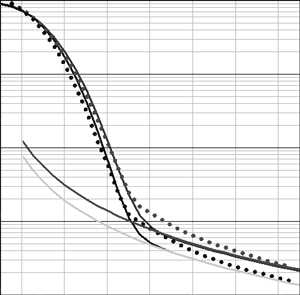Maximum likelihood estimate of the arrival time of ultra-wideband quasi-radio signal with unknown amplitude and phase
DOI:
https://doi.org/10.3103/S0735272718020012Keywords:
arrival time, ultra-wideband quasi-radio signal, maximum likelihood estimate, bias, estimate scatter, estimate dispersion, probability of reliable estimateAbstract
The maximum likelihood algorithm for estimating the arrival time of ultra-wideband quasi-radio signal with unknown amplitude and phase has been synthesized. The duration of the specified signal can amount to several periods or a fraction of harmonic oscillation period. The realization of maximum likelihood algorithm (ML) for estimating the arrival time of ultra-wideband quasi-radio signal is shown to be appreciably more complex than the realization of ML algorithm for estimating the arrival time of narrowband radio signal. The probability of reliable estimate, bias and scattering of ML estimate of the arrival time of ultra-wideband quasi-radio signal have been found with due regard for anomalous errors making it possible to investigate its threshold properties. The computer methods of statistical simulation were used to determine the performance efficiency of the synthesized algorithm of ML estimate and the limits of the application scope of obtained asymptotically exact (with the rise of signal-to-noise ratio) formulas for the characteristics of time arrival estimate of ultra-wideband quasi-radio signal with unknown amplitude and phase.References
- TIKHONOV, V.I. Optimal Signal Reception [in Russian].Moscow: Radio i Svyaz’, 1983.
- KULIKOV, E.I.; TRIFONOV, A.P. Estimation of Signal Parameters against the Background of Interferences [in Russian].Moscow: Sov. Radio, 1978.
- TRIFONOV, A.P.; SHINAKOV, Y.S. Joint Discrimination of Signals and Estimation of their Parameters against the Background of Interferences [in Russian].Moscow: Radio i Svyaz’, 1986.
- TRIFONOV, A.P.; RUDNEV, P.E. Detection of an ultra-wideband quasi radio signal against background random noise. Radiophys. Quantum Electron., v.52, n.9, p.671-681, 2009. DOI: https://doi.org/10.1007/s11141-010-9175-2.
- TRIFONOV, A.P.; RUDNEV, P.E. Detection of an ultra-wideband quasi-radio signal with unknown arrival time against the background of white noise. Radiophys. Quantum Electron., v54, n.6, p.415-429, 2011. DOI: https://doi.org/10.1007/s11141-011-9302-8.
- FONTANA, R.J. Recent system applications of short-pulse ultra-wideband (UWB) technology. IEEE Trans. Microwave Theory Tech., v.52, n.9, p.2087-2104, 2004. DOI: https://doi.org/10.1109/TMTT.2004.834186.
- HUSSAIN, M.G.M. Ultra-wideband impulse radar-an overview of the principles. IEEE Aero. Electron. Syst. Mag., v.13, n.9, p.9-14, 1998. DOI: https://doi.org/10.1109/62.715515.
- IVERSON, D.E. Coherent processing of ultra-wideband radar signals. IEE Proc. Radar, Sonar and Navigation, v.141, n.3, p.171-179, 1994. DOI: https://doi.org/10.1049/ip-rsn:19941164.
- HUSSIAN, M.G.M. Principles of high-resolution radar based on nonsinusoidal waves. I. Signal representation and pulse compression. IEEE Trans. Electromagn. Compat., v.31, n.4, p.359-368, 1989. DOI: https://doi.org/10.1109/15.43630.
- HUSSIAN, M.G.M. Principles of high-resolution radar based on nonsinusoidal waves. II. Generalized ambiguity function. IEEE Trans. Electromagn. Compat., v.31, n.4, p.369-375, 1989. DOI: https://doi.org/10.1109/15.43639.
- MORGAN, M.A. Ultra-wideband impulse scattering measurements. IEEE Trans. Antennas Propag., v.42, n.6, p.840-846, 1994. DOI: https://doi.org/10.1109/8.301704.
- BYKOV, V.V. Digital Simulation in Statistical Radio Engineering [in Russian]. Moscow: Sov. Radio, 1971.

Downloads
Published
2018-02-21
Issue
Section
Research Articles

